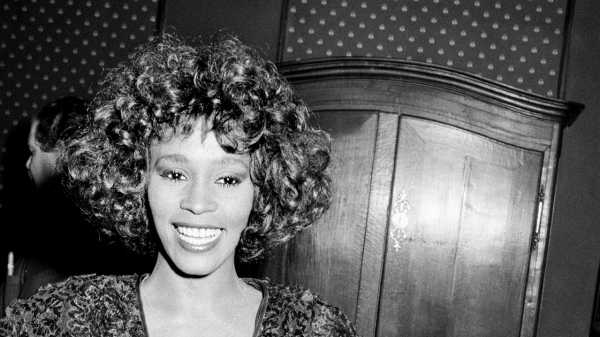
The first thirteen months of the nineteen-nineties delivered two radical, diametrically opposed renditions of “The Star-Spangled Banner.” The first came on July 25, 1990, when Roseanne Barr sang (to use a generous verb) the anthem before a San Diego Padres game. In a blowsy white shirt, Barr was merrily off-key, screeching the notes she couldn’t hit, which were most of them, all while spitting and grabbing her crotch. The crowd booed her off. President George H. W. Bush, a mere week away from the start of the Gulf War, took time on Air Force One to call Barr’s interpretation “disgraceful.” She apologized, but recalled later that she was inundated with death threats afterward, many of them anti-Semitic, and has suggested that the incident hastened the cancellation of her Saturday-morning cartoon, “Little Rosey.”
Then, on January 27, 1991, at Super Bowl XXV, in Tampa, Whitney Houston did the opposite: she sang the national anthem possibly better than it has ever been sung. Operation Desert Storm was now afoot, setting a patriotic mood. Houston, in a white headband and tracksuit, opened her mouth wide, and out of the speakers came sonic fireworks. (Houston was lip-synching a prerecorded track, which became a hit single and was re-released after 9/11.) The TV cameras cut to black and white servicemen in salute, to wide-eyed audience members, to billowing flags. As Houston’s longtime arranger and bandleader, Rickey Minor, would explain, Houston was inspired by Marvin Gaye’s soul rendition of the song at the 1983 N.B.A. All-Star Game. For Houston’s version, Minor changed the time signature from 3/4 to 4/4, to give her more time to linger over the notes.
The playwright Tony Kushner was, at the time, at work on “Angels in America,” which would include this line for the gay black character Belize: “The white cracker who wrote the national anthem knew what he was doing. He set the word ‘free’ to a note so high nobody can reach it.” Barr had screamed the note like a hog being slaughtered; Houston hit that E-flat like the world’s clearest bell, then added a few notes that were even higher, for good measure. As Cinque Henderson wrote in his deconstruction of Houston’s version, “the machinery of state violence has too often been used against black people for a song about bombs and rockets to hold much appeal. But Houston inaugurated a change.” She had remade the anthem in her own image, full of the gospel sheen she had grown up with. (Her mother was the gospel singer Cissy Houston, and Dionne Warwick was a cousin.) The embellishment of “free”—take that, white cracker!—resonated with black America, but, as with all things Whitney, her “Star-Spangled Banner” was a crossover hit, designed to please everyone. From the distance of a quarter century, what the two anthems represent—black excellence, white vulgarity—have a queasy resonance, not just because of the last two Presidents but because of the tangled paths of Barr and Houston—and of the national anthem itself. After all, a black singer could never get away with Barr’s irreverence, any more than black athletes can take the knee without sparking hysteria.
Houston’s Super Bowl performance comes halfway through Kevin Macdonald’s riveting documentary “Whitney,” which opens in theatres this weekend. It sat, after all, at the midpoint of Houston’s career, after the release of her star-making first three albums, for Arista Records, under the aegis of Clive Davis; a year before her world-conquering cover of Dolly Parton’s “I Will Always Love You,” from “The Bodyguard”; and before the long, agonizing, drug-fuelled downfall that ended with her death, in 2012, in a bathtub at the Beverly Hilton. The film, which premièred at Cannes, is inevitably Everest-shaped, with an epic climb followed by an equally epic descent. It’s not the first posthumous documentary about Houston, but it goes startlingly deep, both in the damage it dredges up and in the context it gives to Houston’s achievements.
Once labelled “The Prom Queen of Soul,” by Time, Houston had a good-girl, princess image that made her endlessly palatable to mainstream pop but obscured, or perhaps exacerbated, her demons. The songs that made her famous—“The Greatest Love of All,” “I Wanna Dance With Somebody (Who Loves Me),” “One Moment in Time”—are danceable, hummable, and often saccharine; they tell you almost nothing about Houston, who, as the documentary vividly catalogues, had more than her share of secrets. Her relationship with Robyn Crawford, her best friend and assistant, appears to have been not only sexual but central, making Houston the subject of a turf war between Crawford and Bobby Brown, Houston’s husband of fifteen years. Through canny interviewing, Macdonald (the director of “Marley” and “The Last King of Scotland”) susses out salacious but persuasive claims about Houston’s alleged molestation as a childwas allegedly molested as a child. And then, of course, there was addiction, which brought Houston tabloid infamy and much worse. As one confidante recounts, Houston said that she took drugs because she liked them, but Macdonald traces how addiction might have grown out of even deeper problems, whether sexual repression, trauma, the costs of fame, or plain old loneliness.
Still, Houston wasn’t the type—like her contemporaries Michael Jackson and Madonna, or like her heir Beyoncé—to bring her pain into her music or to push the envelope. Her contradictions remained offstage, until they couldn’t be contained there. What she had was a one-in-a-billion voice, with not just superhuman range but a shimmering tone. She simply had the finest silk in the bazaar, and she knew how to use it. Macdonald gives us generous portions of her first TV appearance, singing “Home” (from the musical “The Wiz”) on “The Merv Griffin Show,” in 1983, when she was nineteen. Her musicianship is unassailable—which makes it all the sadder and more infuriating when it all goes down the drain. Macdonald’s film has drawn comparisons to “Amy,” Asif Kapadia’s Oscar-nominated chronicle of the rise and fall of Amy Winehouse. But, while Kapadia eschews talking heads, Macdonald fills the screen with rueful, emotive faces: of siblings, of friends, of passing acquaintances, of Bobby Brown. They come to resemble, by turns, a Greek chorus, enablers, and bystanders at a crime scene. Unlike another recent documentary, “Whitney: Can I Be Me,” Macdonald’s film was made with the participation of Houston’s family, but he doesn’t toe a party line; he’s probing enough to draw out clashing perspectives and buried truths.
Macdonald also makes artful use of jarring, subversive cuts to highlight the contradictions in Houston’s career. The national-anthem sequence slides between Houston’s soaring performance and images of civil unrest and police brutality. (This was, after all, less than two months before the Rodney King beating.) In an earlier segment, Houston’s bopping, pastel-hued video for “I Wanna Dance With Somebody” is intercut with clips of Ronald Reagan, Coke commercials, and other totems of sunny eighties America—until the footage veers into the 1967 race riots in Newark that shadowed Houston’s childhood. The subtext is that Houston’s crossover Prom Queen image was a cover for more than just her personal demons—it was a fantasy of post-racial relatability. Sometimes, it backfired: at the 1989 Soul Train awards, her name was booed, and her mother heard spectators chanting, “White-y!” Arsenio Hall, asking her about the backlash, on his talk show, said, “You can’t ask a whole crowd, ‘What was that about?’ ” Houston—sitting beside another guest, Roseanne Barr—replied, “I want to say that, and some other things, but…” It’s tantalizing and tragic to think of all the things Houston wanted to say, in the course of her pathbreaking career, and didn’t. We’ll have to settle for the trail of clues she left us, onstage and off.
Sourse: newyorker.com






